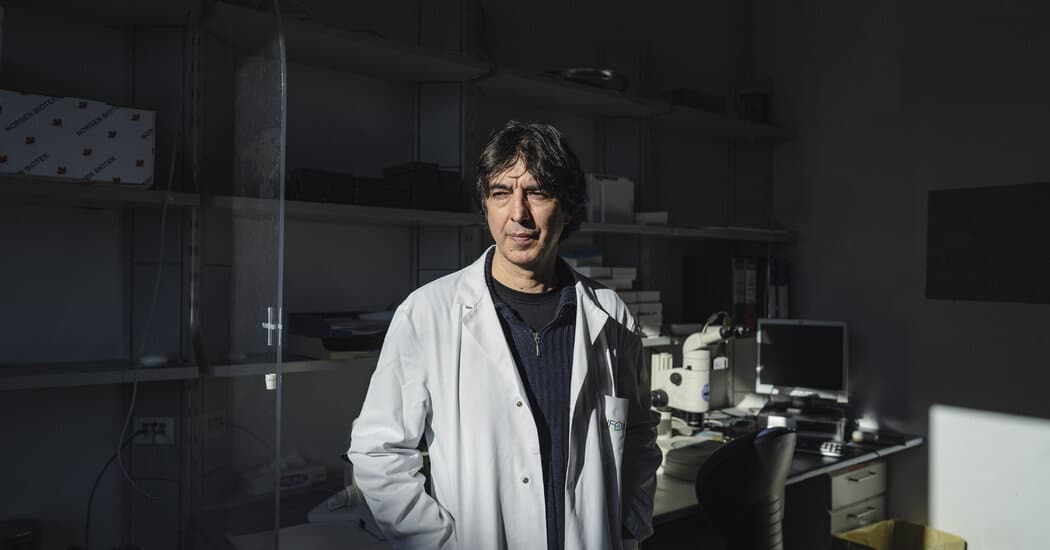[ad_1]
Most members of the band subscribed to a live-fast-die-young lifestyle. But as they partook in the drinking and drugging endemic to the 1990s grunge scene after shows at the Whisky a Go Go, Roxy and other West Coast clubs, the band’s guitarist, Valter Longo, a nutrition-obsessed Italian Ph.D. student, wrestled with a lifelong addiction to longevity.
Now, decades after Dr. Longo dropped his grunge-era band, DOT, for a career in biochemistry, the Italian professor stands with his floppy rocker hair and lab coat at the nexus of Italy’s eating and aging obsessions.
“For studying aging, Italy is just incredible,” said Dr. Longo, a youthful 56, at the lab he runs at a cancer institute in Milan, where he will speak at an aging conference later this month. Italy has one of the world’s oldest populations, including multiple pockets of centenarians who tantalize researchers searching for the fountain of youth. “It’s nirvana.”
Dr. Longo, who is also a professor of gerontology and director of the U.S.C. Longevity Institute in California, has long advocated longer and better living through eating Lite Italian, one of a global explosion of Road to Perpetual Wellville theories about how to stay young in a field that is itself still in its adolescence.
In addition to identifying genes that regulate aging, he has created a plant and nut-based diet with supplements and kale crackers that mimics fasting to, he argues, allow cells to shed harmful baggage and rejuvenate, without the down side of actually starving. He has patented and sold his ProLon diet kits; published best-selling books (“The Longevity Diet”); and been called an influential “Fasting Evangelist” by Time magazine.
Last month, he published a new study based on clinical trials of hundreds of older people — including in the Calabria town from which his family hails — that he said suggests that periodic cycles of his own faux-fasting approach could reduce biological age and stave off illnesses associated with aging.
His private foundation, also based in Milan, tailors diets for cancer patients, but also consults for Italian companies and schools, promoting a Mediterranean diet that is actually foreign to most Italians today.
“Almost nobody in Italy eats the Mediterranean diet,” said Dr. Longo, who has a breezy California manner and Italian accent. He added that many Italian children, especially in the country’s south, are obese, bloated on what he calls the poisonous five Ps — pizza, pasta, protein, potatoes and pane (or bread).
At the foundation recently, the resident nutritionist, Dr. Romina Cervigni, sat amid pictures on the wall showing Dr. Longo playing guitar with centenarians, and shelves of his longevity diet books, translated into many languages and filled with recipes.
“It’s very similar to the original Mediterranean diet, not the present one,” she said, pointing at photographs on the wall of a bowl of ancient legumes similar to the chickpea, and of a Calabrian green bean pod prized by Dr. Longo. “His favorite.”
Dr. Longo, who has split his time between California and Italy for the past decade, once occupied a niche field. But in recent years, Silicon Valley billionaires who hope to be forever young have funded secretive labs. Wellness articles have conquered newspaper home pages and Fountains-of-Youth workout and diet ads featuring insanely fit middle-aged people teem on the social media feeds of not insanely fit middle-aged people.
But even as concepts like longevity, intermittent fasting and biological age — you’re only as old as your cells feel! — have gained momentum, governments like Italy’s are fretting over a creakier future in which booming populations of old people drain resources from the dwindling young.
And yet many scientists, nutritionists and longevity fanatics the world over continue to stare longingly toward Italy, seeking in its deep pockets of centenarians a secret ingredient to long life.
“Probably they kept breeding between cousins and relatives,” Dr. Longo offered, referring to the sometimes close relations in little Italian hill towns. “At some point, we suspect it sort of generated the super-longevity genome.”
The genetic drawbacks of incest, he hypothesized, slowly vanished because those mutations either killed their carriers before they could reproduce or because the town noticed a monstrous ailment — like early onset Alzheimer’s — in a particular family line and steered clear. “You’re in a little town, you’re probably going to get tagged.”
Dr. Longo wonders whether Italy’s centenarians had been protected from later disease by a starvation period and old-fashioned Mediterranean diet early in life, during rural Italy’s abject war-era poverty. Then a boost of proteins and fats and modern medicine after Italy’s postwar economic miracle protected them from frailty as they got older and kept them alive.
It could, he said, be a “historical coincidence that you’ll never see again.”
The mysteries of aging seized Dr. Longo at a young age.
He grew up in the northwestern port of Genoa but visited his grandparents back in Molochio, Calabria, a town known for its centenarians, every summer. When he was 5, he stood in a room as his grandfather, in his 70s, died.
“Probably something very much preventable,” Dr. Longo said.
At age 16, he moved to Chicago to live with relatives and couldn’t help notice that his middle-aged aunts and uncles fed on the “Chicago diet” of sausages and sugary drinks suffered diabetes and cardiovascular disease that their relatives back in Calabria did not.
“This was like the ’80s,” he said, “just like the nightmare diet.”
While in Chicago, he often went downtown to plug in his guitar at any blues club that would let him play. He enrolled in the renowned jazz guitar program at the University of North Texas.
“Even worse,” he said. “Tex-Mex.”
He ultimately ran afoul of the music program when he refused to direct the marching band, so he shifted his focus to his other passion.
“Aging,” he said, “it was in my head.”
He eventually earned his Ph.D in biochemistry at U.C.L.A. and did his postdoctoral training in the neurobiology of aging at U.S.C. He overcame early skepticism about the field to publish in top journals and became a zealous evangelizer for the age-reversing effects of his diet. About 10 years ago, eager to be closer to his aging parents in Genoa, he took a second job at the IFOM oncology institute in Milan.
He found a fount of inspiration in the pescatarian-heavy diet around Genoa and all the legumes down in Calabria.
“Genes and nutrition,” he said of Italy as an aging lab, “it’s just unbelievable.”
But he also found the modern Italian diet — the cured meats, layers of lasagna and fried vegetables the world hungered for — horrendous and a source of disease. And like other Italian aging researchers who are seeking the cause for aging in inflammation or hoping to zap senescent cells with targeted drugs, he said Italy’s lack of investment in research was a disgrace.
“Italy’s got such incredible history and a wealth of information about aging,” he said. “But spends virtually nothing.”
Back at his lab — where colleagues prepared the fasting-mimicking diet “broth mix” for mice — he passed a photograph on a shelf depicting a broken wall and reading, “We’re slowly falling apart.” He talked about how he and others had identified an important regulator of aging in yeast, and how he has investigated whether the same pathway was at work in all organisms. He said his research benefited from his past life of musical improvisation, because it opened his mind to unexpected possibilities, including using his diet to starve cells afflicted with cancer and other diseases.
Dr. Longo said he thinks of his mission as extending youth and health, not simply putting more years on the clock, a goal he said could lead to a “scary world,” in which only the rich could afford to live for centuries, potentially forcing caps on having children.
A more likely short-term scenario, he said, was division between two populations. The first would live as we do now and reach about 80 or longer through medical advancements. But Italians would be saddled with long — and, given the drop in the birthrate, potentially lonely — years burdened by horrible diseases. The other population would follow fasting diets and scientific breakthroughs and live to 100 and perhaps 110 in relative good health.
A practitioner of what he preaches, Dr. Longo envisioned himself in the latter category.
“I want to live to 120, 130. It really makes you paranoid now because everybody’s like, ‘Yeah, of course you got at least to get to 100,’” he said. “You don’t realize how hard it is to get to 100.”
Source link











